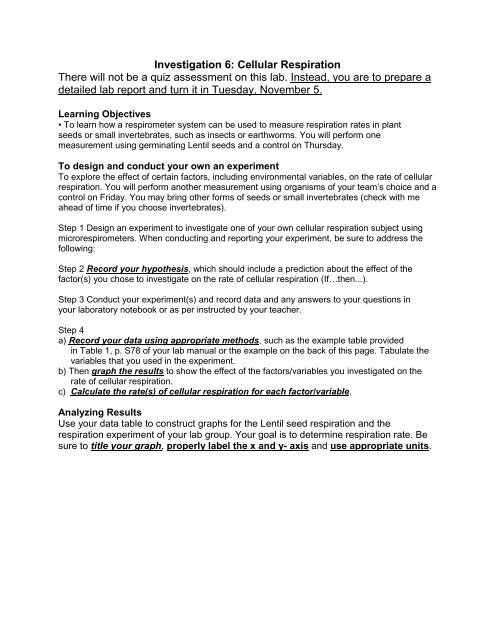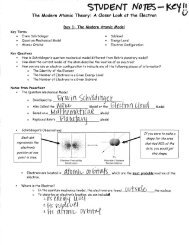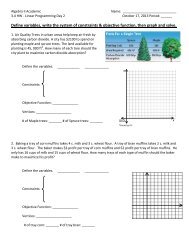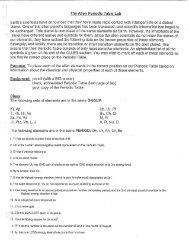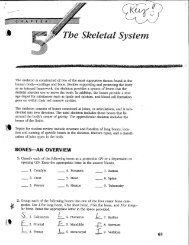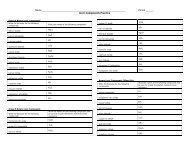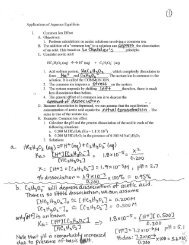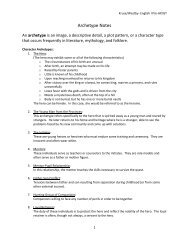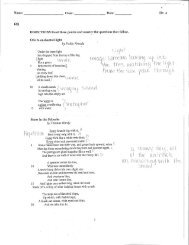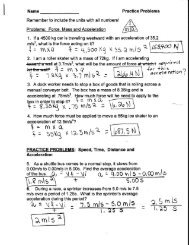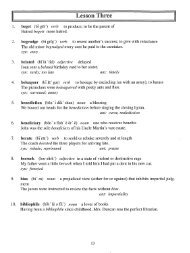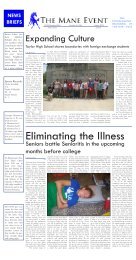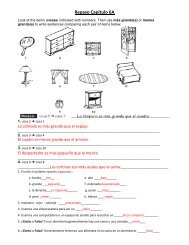Investigation 6: Cellular Respiration There will not be a quiz ...
Investigation 6: Cellular Respiration There will not be a quiz ...
Investigation 6: Cellular Respiration There will not be a quiz ...
You also want an ePaper? Increase the reach of your titles
YUMPU automatically turns print PDFs into web optimized ePapers that Google loves.
<strong>Investigation</strong> 6: <strong>Cellular</strong> <strong>Respiration</strong><br />
<strong>There</strong> <strong>will</strong> <strong>not</strong> <strong>be</strong> a <strong>quiz</strong> assessment on this lab. Instead, you are to prepare a<br />
detailed lab report and turn it in Tuesday, Novem<strong>be</strong>r 5.<br />
Learning Objectives<br />
• To learn how a respirometer system can <strong>be</strong> used to measure respiration rates in plant<br />
seeds or small invertebrates, such as insects or earthworms. You <strong>will</strong> perform one<br />
measurement using germinating Lentil seeds and a control on Thursday.<br />
To design and conduct your own an experiment<br />
To explore the effect of certain factors, including environmental variables, on the rate of cellular<br />
respiration. You <strong>will</strong> perform a<strong>not</strong>her measurement using organisms of your team’s choice and a<br />
control on Friday. You may bring other forms of seeds or small invertebrates (check with me<br />
ahead of time if you choose invertebrates).<br />
Step 1 Design an experiment to investigate one of your own cellular respiration subject using<br />
microrespirometers. When conducting and reporting your experiment, <strong>be</strong> sure to address the<br />
following:<br />
Step 2 Record your hypothesis, which should include a prediction about the effect of the<br />
factor(s) you chose to investigate on the rate of cellular respiration (If…then...).<br />
Step 3 Conduct your experiment(s) and record data and any answers to your questions in<br />
your laboratory <strong>not</strong>ebook or as per instructed by your teacher.<br />
Step 4<br />
a) Record your data using appropriate methods, such as the example table provided<br />
in Table 1, p. S78 of your lab manual or the example on the back of this page. Tabulate the<br />
variables that you used in the experiment.<br />
b) Then graph the results to show the effect of the factors/variables you investigated on the<br />
rate of cellular respiration.<br />
c) Calculate the rate(s) of cellular respiration for each factor/variable.<br />
Analyzing Results<br />
Use your data table to construct graphs for the Lentil seed respiration and the<br />
respiration experiment of your lab group. Your goal is to determine respiration rate. Be<br />
sure to title your graph, properly la<strong>be</strong>l the x and y- axis and use appropriate units.
Answer the following in your report:<br />
When does cellular respiration occur?<br />
Are there any situations when living cells are <strong>not</strong> respiring? What are they?<br />
Why might some living cells respire more than others?<br />
Are there differences <strong>be</strong>tween major groups of organisms in how fast they respire?<br />
Why?<br />
What is the difference, if any, in the rate of cellular respiration <strong>be</strong>tween germinating<br />
seeds and nongerminating seeds?<br />
How does the temperature of germinating seeds affect the rate of cellular respiration?<br />
Do plant seeds consume more oxygen at higher temperatures than at lower<br />
temperatures? Explain why or why <strong>not</strong>.<br />
Do available nutrients affect the rate of respiration in germinating seeds?


